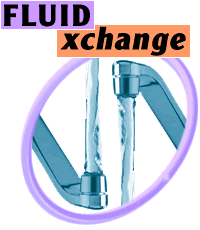I went to an AIDS function the other day and had quite a tasty lunch: several different salads, delicatessen sandwiches, rich pastries and wine.
It was only afterwards that I realized something was different. This was an AIDS function and the lunch was not provided by a pharmaceutical company. The event was at the University Of Toronto, which provided the lunch.
That ubiquitous little propped up sign – meal “provided courtesy of” Abbott or Agouron or Bristol Myers-Squibb or whatever – was actually noticeable by its absence.
Project Inform’s proposed guidelines on ethical relations between HIV community agencies and pharmaceutical companies, which I wrote about in the last issue, don’t actually talk about free meals. Still, they are one small but important way the pharmaceutical industry tries to buy goodwill among AIDS service organizations (ASOs), agency staff and PWAs.
“Sure, they use food to attract people,” says Dr Joel Lexchin, probably Canada’s pre-eminent pharmaceutical company watchdog. “If it’s in a hospital, lunches are catered and better than in the cafeteria. And then there are evening sessions in good restaurants with good wine.”
This constant offering of tasty food “is really a metaphor [to convince you] the drug companies care about you,” Lexchin says.
Government funding for ASOs is declining. Pharmaceutical companies want to expand their markets, and they have a track record of a devoting a sizable percentage of sales revenues to promotion.
Many PWAs, meanwhile, are dependent on the medications produced by the pharmaceutical industry for their very survival. The situation is ripe for drug companies to exert undue influence on susceptible ASOs in an effort to gain access to a greater market share.
For all these reasons, San Francisco-based Project Inform says it is imperative that ASOs begin to challenge the role of industry influence.
“This doesn’t mean agencies need to reject industry funding. On the contrary, as the one most profiting from the epidemic, the pharmaceutical industry should be offering support back to the community. [But] support must come with the fewest possible strings.”
There’s been “a dramatic change in AIDS organizations from a stance of conflict or hostility toward the pharmaceutical industry, to one of accommodation,” says Eric Mykhalovsky, former board member of the Canadian AIDS Treatment Information Exchange (CATIE) and a health policy specialist.
And when it comes to discussion of the ethics of relationships with the industry, “there’s a deafening silence,” he says.
Project Inform suggests three guiding principles for ethical relations: disclosure of financial support from the industry, structured communication policy of who should talk to who, and independence and ownership – community agencies should control their own agenda and create their own programs.
That third principle is critical because there are some things the industry obviously doesn’t want to promote.
The pharmaceutical industry is clearly interested in supplying drug treatment information to ASOs, and Derek Thaczuk, treatment counsellor at Toronto’s PWA Foundation.
“You’re not likely to see glossy brochures about the benefits of not being on medications, or of the benefits of complementary therapies.”
Similarly, activist Toronto Rick Bebout notes the industry has also not been particularly interested in pushing effective but inexpensive drugs, such as Septra.
“Every company has a marketing motivation… but really, the drug companies are neither friends nor enemies,” Bebout says.
Still, as PWA’s Glen Hillson notes, the companies “sure do hire such nice people [for community liaison]. We often laugh about what gosh-darn nice people they hire.”
When it comes to personable drug company representatives, ASO staff should keep a good perspective.
“Some people appear to be taken in by these kind of pseudo-friendships. The personal relationships are artificial; no one should be misled about their motives,” says Dr Philip Berger, who has frequently blown the whistle on unethical relations between the medical profession and the drug industry.
Women’s health groups in Canada have also been watching the pharmaceutical industry closely for some time. Last year, the National Networks On Environments And Women’s Health at York University funded the booklet A Different Prescription for women’s health groups contemplating funding from the pharmaceutical industry.
“Pharmaceutical companies pay big dollars to change the way people think. They are really very good at it,” says booklet author Anne Rochon Ford.
An informal survey of some ASOs revealed that while many have certain practices with respect to how they interact with the pharmaceutical industry, most have only a few, if any, written policies.
“Our guidelines are general and don’t deal with the pharmaceutical industry,” said Lee Zaslovsky, communications officer with the AIDS Committee Of Toronto. The Project Inform proposals “are excellent and will help us reshape ours,” he said.
While CATIE has policies about industry relations for fund development, it has not explicitly addressed many of the areas covered by Project Inform, says executive director Anne Swarbrick.
While Toronto’s 10-year-old PWA Foundation has established practices for dealing with industry, it is just now embarking on the task of putting together a written policy manual, Thaczuk says.
None of the agencies I contacted had explicit disclosure of industry funding in their annual reports. But in interviews, ASO spokespeople reported industry funding during 1999 that ranged from miniscule to substantial proportions. At the low end was Toronto PWA Foundation, with 0.19 percent of its overall budget from the pharmaceutical industry.
The AIDS Committee Of Toronto spokesperson said ACT receives industry funding only through sponsorship of events, and reported that of total funds raised that way, drug company donations amounted to roughly 1.67 percent of its total revenue, which was $3.84-million in 1998-99.
Swarbrick said CATIE received nine percent of its funding from the corporate sector (about two-thirds from pharmaceutical companies), all of it project-specific funding. The Canadian Treatment Advocacy Council receives about half of its funding fromthe pharmaceutical industry, most of it in unrestricted grants.
None of the organizations had a readily available package of relevant policies that interested members of the public could obtain.

 Why you can trust Xtra
Why you can trust Xtra


